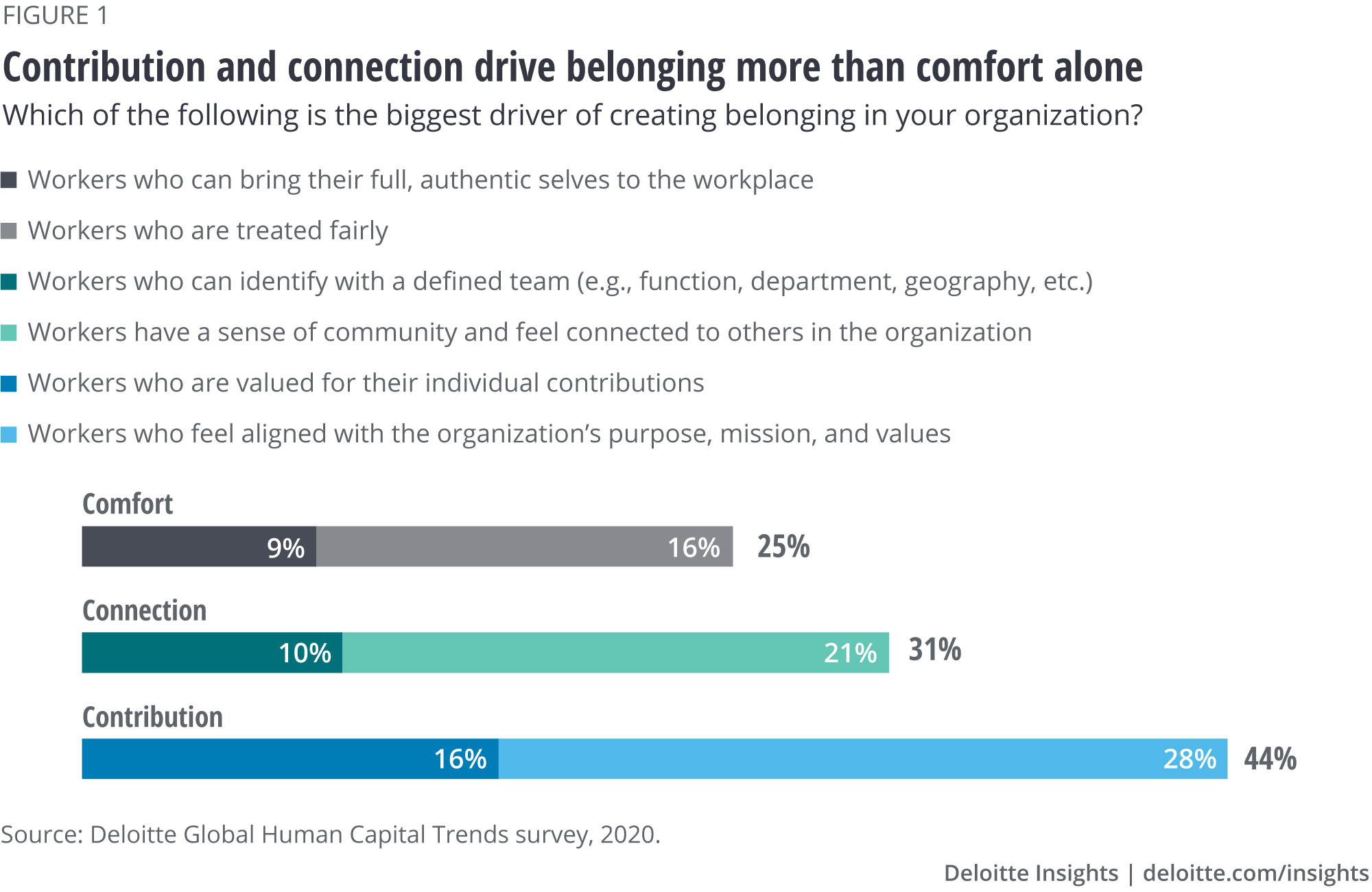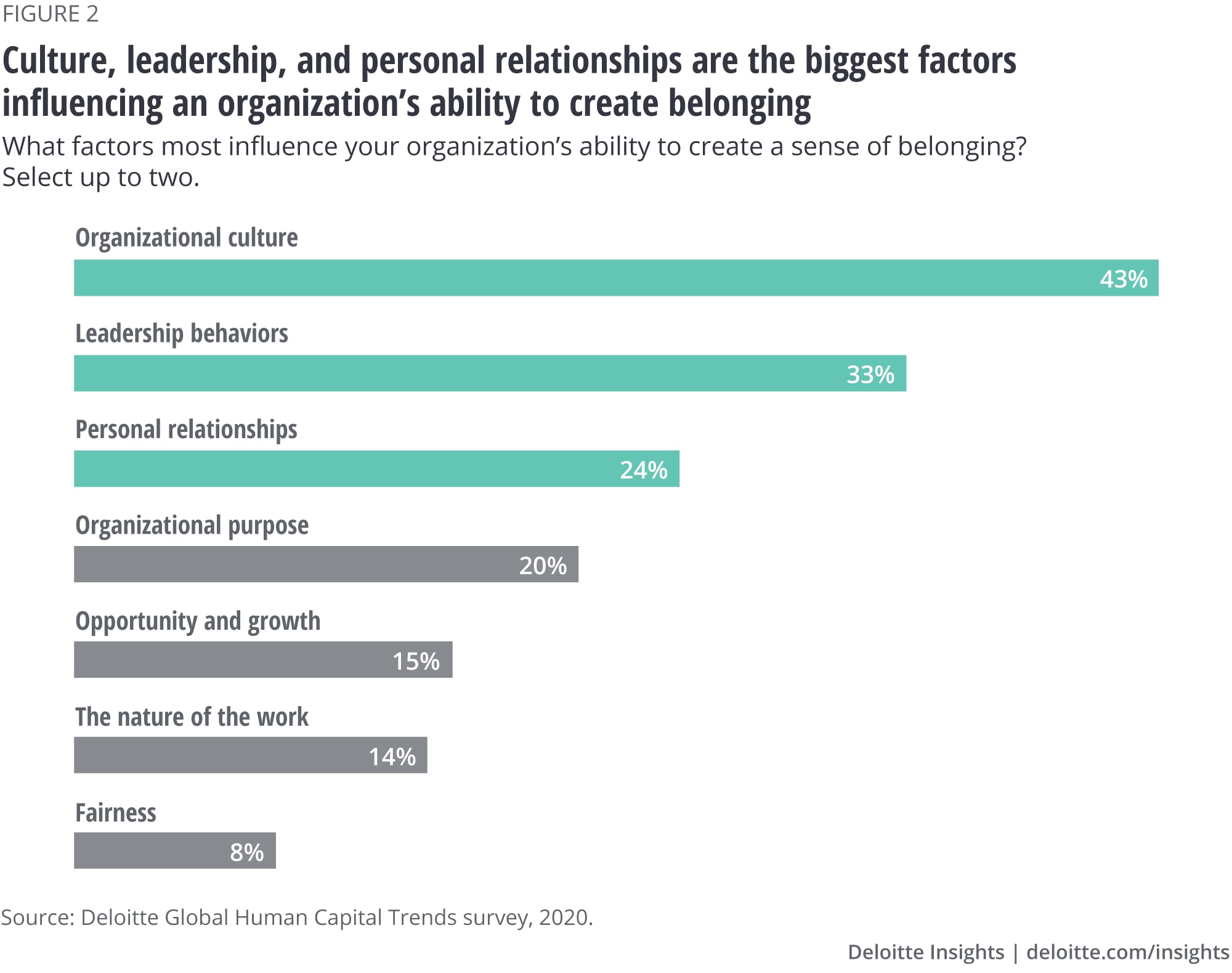
Belonging From comfort to connection to contribution
When workers appreciate how their individual work helps to advance goals they support and find meaningful, they will likely be more engaged, more motivated, and more likely to perform at a high level.
2021 Global Human Capital Trends
Sign up to receive a copy of our new approach to Trends launching this winter
Organizational efforts to foster belonging have historically and primarily focused on making every individual feel respected and treated fairly in an inclusive work environment. While this remains foundational, leading organizations are forging a stronger link between belonging and organizational performance by strengthening workers’ connections with their teams and fostering their sense of contribution to meaningful shared goals.
The Readiness Gap: Seventy-nine percent of organizations say fostering a sense of belonging in the workforce is important or very important for their success over the next 12 to 18 months, but only 13 percent say they are very ready to address this trend.
Learn more
Explore the Human Capital Trends collection
Watch the video
Learn about Deloitte's services
Order a copy of Work Disrupted, Deloitte's new book on the accelerated future of work
Explore 5 lessons from the pandemic for the future of work
Go straight to smart. Get the Deloitte Insights app
Current drivers
Belonging, along with well-being, is at the top of this year’s Global Human Capital Trends survey as one of the most important human capital issues. Seventy-nine percent of survey respondents said that fostering a sense of belonging in the workforce was important to their organization’s success in the next 12–18 months, and 93 percent agreed that a sense of belonging drives organizational performance—one of the highest rates of consensus on importance we have seen in a decade of Global Human Capital Trends reports.
Of course, belonging—including the sense of feeling respected and treated fairly—has been an organizational priority for some time. Promoting respect and fairness for all is a large part of many organizations’ diversity and inclusion efforts, and those efforts, when effective, pay off. A 2019 study by BetterUp found that workplace belonging can lead to an estimated 56 percent increase in job performance, a 50 percent reduction in turnover risk, and a 75 percent decrease in employee sick days. The study found that a single incidence of “micro-exclusion” can lead to an immediate 25 percent decline in an individual’s performance on a team project.1
Why has belonging at work become a top organizational priority now? Some of it is external. Many people feel the world is becoming less stable, more polarized, and more volatile. In many countries, political polarization, tribalism, and populism are on the rise.2 The World Economic Forum has observed increased “public frustration with the status quo, populist insurgencies, [and] the division of groups into ‘us-vs-them’” in countries as diverse as the United States, France, Germany, the United Kingdom, Italy, Hungary, Austria, Sweden, Poland, Brazil, the Philippines, and others.3 A recent study of six of those countries uncovered that these divisions are likely “more than just shifts in public opinion about specific issues,” but instead may reflect a deepening distrust in society “with growing tribalism and intolerance of those with different beliefs and background.”4 These divisions may be leading some individuals to turn to the workplace to find the sense of meaning and solidarity that is often becoming more and more difficult to achieve with society at large.
Even in the workplace, that solidarity can sometimes be hard to find. The Society for Human Resource Management’s (SHRM’s) Politics at Work survey found that 42 percent of US employees surveyed had personally experienced political disagreements in the workplace, and 34 percent said that their workplace is not accepting of differing political perspectives. SHRM notes that, while companies “can’t, and shouldn’t try to, quash these conversations … [they can] create inclusive cultures of civility where difference isn’t a disruption.” 5
And many organizations are struggling with fostering belonging in a polarized world. Even organizations that are known for their emphasis on psychological safety and openness have needed to issue new guidelines to reduce disruptive workplace discussions. In one example, a company circulated a memo asking workers to avoid any conversations that might be disruptive to the workplace or lead to divisions among employee groups. The organization scaled back weekly meetings where employees could previously discuss anything—including political issues—with senior leaders and shifted their focus instead to monthly sessions focused on business strategy.
External factors aren’t all that is driving belonging’s importance; what’s happening within the organization is having an impact as well. Shifts in workforce composition are one growing challenge. With alternative work arrangements on the rise, many workers may not formally “belong” to the organization they work for—which can make it harder for them to feel a sense of belonging at work and can make it harder for people in traditional work arrangements to feel a sense of unity with them. Workplace technology is also a contributing force. While technology enables instantaneous communication with virtually anyone, the way people use that technology can—paradoxically—contribute to increased feelings of isolation. Many virtual workers cite loneliness as one of remote working’s challenges.6 It’s a challenge faced by an increasing number of workers: In the United States, the number of people who regularly work from home has grown by 173 percent since 2005.7
These forces are playing out against a backdrop where many people are working longer hours. As work consumes more waking hours than ever before, people are looking to work to provide more than just a paycheck. Since the Great Depression in the 1930s, the average American workweek has risen from about 35 hours to a standard 40, and many people log more than that:8 Workers in full-time jobs in the United States worked just over 9.3 hours on an average weekday in 2017.9 Some observers note that, as working hours have lengthened, people are increasingly looking to work for personal fulfillment and satisfaction10—which can include, among other things, a sense of belonging.
Our 2020 perspective
Our view is that creating a sense of belonging at work is the outcome of three mutually reinforcing attributes. Workers should feel comfortable at work, including being treated fairly and respected by their colleagues. They should feel connected to the people they work with and the teams they are part of. And they should feel that they contribute to meaningful work outcomes—understanding how their unique strengths are helping their teams and organizations achieve common goals.
Our 2020 Global Human Capital Trends survey results offer support for this view. Twenty-five percent of survey respondents identified fostering an environment where workers feel they are treated fairly and can bring their authentic selves to work—comfort—as the biggest driver of belonging. Thirty-one percent said that having a sense of community and identifying with a defined team—connection—was the biggest driver. And 44 percent, a plurality, reported that feeling aligned to the organization’s purpose, mission, and values and being valued for their individual contributions—contribution—was the biggest driver of belonging at work (figure 1).

Belonging through the years in Global Human Capital Trends
This year’s “Belonging” chapter explores the evolution from comfort to connection to contribution— suggesting that workers can find purpose and value in work when they are able to identify the impact they are making on organizational objectives and goals. This year’s point of view builds on a decade of research that first showed how diversity and inclusion drive business performance in 2011; pointed to the importance of diversity of thinking, insights, and ideas in 2013; and emphasized the need to combine diversity with an inclusive culture to truly drive value in 2014. Our 2017 chapter “Diversity and inclusion: The reality gap” reinforced the importance of connection when we wrote about the importance of creating diverse, inclusive teams in which people feel able to speak up and contribute to drive organizational performance. The move from connection to contribution, however, depends on another factor: meaning. In last year’s “From employee experience to human experience” chapter, we wrote about the importance of embedding meaning into work and enabling employees to contribute in the most positive, supportive, and personal ways. This year, we build on that conversation to show that organizations that wish to be inclusive must move beyond making people feel comfortable at work; they should also foster a sense of belonging by giving workers the ability to contribute in meaningful ways to advance team and organizational outcomes.
The progression from comfort to connection to contribution is an additive one, with each step building on the one before. Many organizations have already made great progress on comfort—creating an inclusive environment where workers feel respected and treated fairly. Organizations that establish this kind of inclusive culture are twice as likely to meet or exceed financial targets, three times as likely to be high-performing, six times as likely to be innovative and agile, and eight times more likely to achieve better business outcomes.11
Connection, the next step, occurs on two levels: when workers feel they have meaningful relationships with coworkers and their teams, and when they feel connected with the organization’s purpose and goals. The advent and continuing popularity of business resource groups—groups aimed at connecting and empowering people with similar backgrounds and social identities—is one example of how organizations have promoted stronger connections among workers. One example of the power of workers feeling connected with a broader purpose can be seen in Unilever’s “Brands with a Purpose” initiative, which creates products that are both affordable and commercially viable for consumers in rural villages. People working on Brands with a Purpose teams have the highest engagement scores at the company, and the brands themselves are growing 69 percent faster than the rest of the business.12
The third step, contribution, takes comfort and connection still further. When workers feel a sense of contribution, they can not only feel respected and treated fairly at work and have strong relationships with their colleagues and teams, but workers can also see how their individual talents and efforts make a meaningful difference in advancing team and organizational outcomes. To put it simply, they can see how what they do truly matters in the pursuit of common valued goals. Our survey results support the link between a feeling of contribution and a feeling of belonging: Sixty-three percent of our survey respondents, when asked how creating a sense of belonging supports organizational performance, answered that it does so by enhancing alignment between individual and organizational objectives.
One example of an organization that strives for a culture in which everyone feels able to contribute to meaningful work outcomes is Alibaba. Says Alibaba CEO Zhang Yong: “The essence of Alibaba’s culture is that we have faith in each one of us.” Alibaba recognizes that making it safe for workers to express their views and opinions is the only way to drive the kind of meaningful collaboration that can translate its workforce’s incredible diversity into business value.13
An appreciation of one’s contribution to the work can help foster belonging in a more diverse and even polarized world. Belonging based on contribution does not require people to agree on (for instance) their political views or conform to a single cultural template. Instead, it celebrates individuals’ and teams’ diversity of thought in ways that promote their commitment to shared outcomes, enabling them to engage in discussions that consider a variety of perspectives with the aim of coming to an agreement. When teams are united by a common purpose, differences in opinion on matters unrelated to that purpose can become less relevant—and differences in opinion on how to achieve that purpose become grounds for reasonable dialogue rather than a source of divisiveness.
Our Global Human Capital Trends survey suggests that three factors most influence an organization’s ability to navigate the evolution from comfort to connection to contribution: organizational culture, leadership behaviors, and personal relationships (figure 2).

Organizational culture refers to the system of values, beliefs, and behaviors that shapes how work gets done within an organization. In a culture of belonging, that means an environment that supports all three elements of comfort, connection, and contribution. Workers should feel their perspectives are respected and valued; the culture should be one that encourages everyone to be authentic, share their diverse perspectives, and align to the team’s and organization’s purpose. And workers need clear mechanisms, such as incentives and peer/supervisor feedback, to show them how their work makes a difference in the pursuit of broader shared goals.
Such an organizational culture is built on leadership behaviors that reinforce organizational values of fairness, respect, and psychological safety on teams and inspire workers to perform at their best. Deloitte’s “As One” research program, which studied the structure and productivity of different types of teams, found three types of team leaders were able to build a stronger sense of contribution amongst their teams: “sports team captains,” “community organizers,” and “senators.”14 Characteristically within these archetypes, the leaders united the teams through common goals rather than by top-down rules, and team members had the autonomy to make decisions and provide input instead of following a command-and-control structure.
Finally, the quality of the relationships among team members is critical. Again, comfort and connection are important in facilitating contribution here. Teams where workers feel psychologically safe bringing their views to the table, and where their relationships with other team members are strong enough to allow them to do so in an assertive yet constructive way, will be well positioned to engage in productive friction—the ability to draw out conflict and learn from disagreements to generate new insights.15
Learning by example
Examples of organizations’ efforts around comfort, connection, and contribution illustrate the value of each of these attributes to an organization’s performance. The life sciences company Gilead Sciences recently undertook an effort to increase comfort among its teams in Asia, aiming to instill a sense of psychological safety where workers felt safe to speak up, make mistakes, and be themselves without fear of punishment or judgment. The company worked with its leaders in the region to build inclusive leadership skills and help them understand how to reduce the effects of their own status bias (such as by giving team members opportunities to raise concerns). The objective of this effort is to build a culture in the region where workers can feel empowered to respectfully challenge norms, allowing them to proactively rather than reactively identify issues and opportunities. Gilead is aiming for higher performance and greater innovation by breaking the culture of conformity and encouraging team members to be different and express divergent views.16
Horizon Therapeutics established connection in its organization with a series of efforts intended to promote and celebrate the importance of inclusive thinking and actions. The company explicitly promotes “allyship” in the workplace by identifying and supporting workers who exemplify inclusive behaviors in their daily interactions with diverse colleagues and teams. Horizon looks for four characteristics in its allies: “Being good at learning and listening, feeling comfortable speaking up and speaking out, owning and sharing their own story, and modeling positive, inclusive behaviors.”17 These efforts are paying off in terms of workplace culture. In addition to being recognized for several years as one of the “Best Workplaces in Health Care and Biopharma” by Fortune magazine and the organization Great Place to Work,18 Horizon is credited with creating a familial environment where employees feel connected to the work and their coworkers, as well as believe they have a voice in decision-making.19
Finally, the United States’ National Aeronautics and Space Administration (NASA) continues to cultivate belonging based on a sense of contribution. Robert Gibbs, associate administrator for the Mission Support Directorate, told us, “From an astronaut to an accountant, we’re all pulling on the same rope, in the same direction, trying to achieve the same thing.”20 As it works to land the first woman and next man on the moon by 2024, NASA maintains a strong sense of mission across its entire workforce, even though its workforce’s composition includes a broadly distributed range of workers, including federal employees as well as a high percentage of contract workers, commercial partners, and partners from international cooperative agreements. NASA remains one of the aerospace industry’s most sought-after employers, and leaders attribute much of its success—and astonishingly low 3 percent attrition rate—to its ability to highlight each individual’s role in achieving a clear and compelling organizational purpose.21 Regardless of their job or employment arrangement, everyone at NASA can see how their individual talents contribute to their team and how that work, combined, moves NASA forward.
Pivoting ahead
Organizations have and continue to invest enormous amounts of leadership focus, energy, and resources to ensure people feel respected and are treated fairly at work. Now, leaders have the opportunity to build on comfort to encourage connection and contribution as well, enabling a sense of belonging that can improve organizational performance. Implementing these types of belonging strategies will not be easy. It will require organizations to have a diversity lens to help make sure they are creating the opportunity for everyone to contribute equitably. When workers see and appreciate how their individual work helps to advance goals they support and find meaningful, they will likely be more engaged, more motivated, and more likely to perform at a high level to drive gains in organizational performance.
© 2021. See Terms of Use for more information.
Explore the collection
-
Knowledge management Article4 years ago
-
The compensation conundrum Article4 years ago
-
Governing workforce strategies Article4 years ago
-
Ethics and the future of work Article4 years ago
-
A memo to HR Article4 years ago
-
Introduction Article4 years ago
























